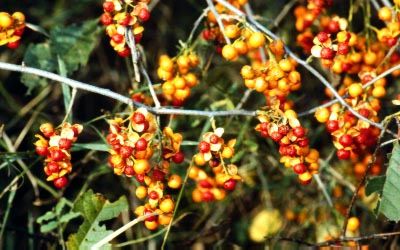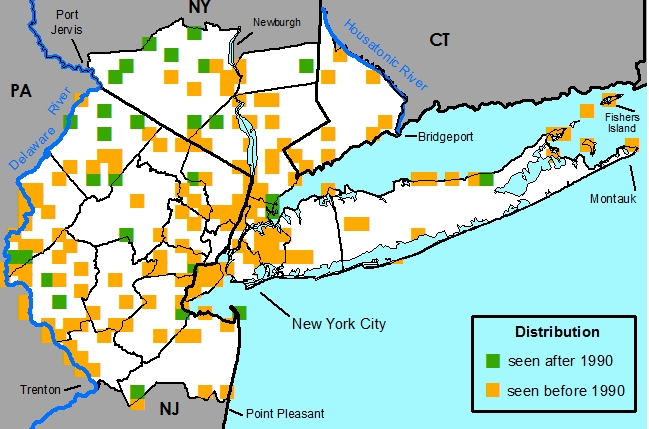Celastrus scandens L. - American Bittersweet
Common Names
American BittersweetField Identification
A scandent shrub or more commonly a vine with bright yellow and orange fruit in the fall. Differs from the related Oriental Bittersweet in having terminal inflorescences, usually narrower and ovate leaves, and is much less common in the region today.Food uses
Disclaimer The information provided here is for reference and historical use. We do not recommend nor do we condone the use of this species for food purposes without first consulting a physician.The inner bark has been used as an emergency food by the Menominee, Ojibwa, and Potawatami.
Medicinal uses
Disclaimer The information provided here is for reference and historical use. We do not recommend nor do we condone the use of this species for medicinal purposes without first consulting a physician.Various parts of the plant have been used by a large number of peoples for a wide variety of ailments, including cough (root), intestinal and gynecological purposes.
Other uses
Often collected in the fall for the colorful berries and arils, which are used in dry flower arrangements.Common Names
American Bittersweet
Bourreau des Arbres
Climbing Bittersweet
Climbing Orange Root
False Bittersweet
Fever Twig
Manidobima'kwit (Ojibwa)--means "spirit twisted" and refers to the twisted intestines of their cultural hero, Winabojo (Moerman, 1998)
Red Root
Roxbury Waxwort
Shrubby Bittersweet
Staff Tree
Staff Vine
Poisonous Properties
Disclaimer The information provided here is for reference and historical use. If you believe you have been poisoned, please contact the Poison Control Office near you. (Look for the number in the front of the phone book.)
(Moerman, D. E., 1998), (Lampe & McCann, 1985)
The berries were considered poisonous by the Iroquois and Oglala. All parts are reported to be poisonous, but there are no reports of the poisonous principal.
Nomenclature
Celastrus scandens L., Sp. Pl. 196. 1753. Euonymoides scandens Medic., Philos. Bot. 1: 173. 1789. TYPE: Unknown.Celastrus bullata L., Sp. Pl. 196. 1753. TYPE: Unknown.
Description
PLANTS perennial, deciduous, phanerophytic or liana, shrubs or woody vines, monoclinous.STEMS climbing, round. Prickles absent. Bark striate, not exfoliating, dark brown or brown. Branches horizontal. Twigs light gray, not odoriferous, round, 2-3 mm in diam., smooth, glabrous, without glands. Pith present, white, round, continuous, nodal diaphram absent. Thorns absent. Aerial roots absent. Sap translucent. Resin absent.
BUDS axillary only, scattered along stem, 1 per axil, ovoid, 1 mm long, pointed. Bud scales 4, orange, imbricate, broadly ovoid, membranaceous, acute, papillose, without glands. Bud scale scars not encircling the stem. Leaf scars U-shape or circular, 0.9-1 mm high, 1.1-1.2 mm wide. Vascular bundle scars 1, crescent-shaped, 0.2-0.3 mm tall.
LEAVES alternate, spiral, 1 per node, spaced somewhat evenly along stem, divergent from stem, simple. Stipules present, lateral, deciduous, free from the petiole, filiform, margins pectinate. Leaves petiolate, petiole terete, 0.5-2.5 cm long, glabrous. Without glands. Leaf blades greenish-yellow, elliptic or obovate, plane, bilaterally symmetric, 4.3-12 cm long, 2.7-5.5 cm wide, membranaceous, base cuneate or obtuse, margin crenate-serrate, apex acuminate or acute, glandular-mucronate, glabrous, without glands, veination eucamptodromous, veins 4-6 pairs. Spines absent. Tendrils absent.
INFLORESCENCES bisexual, simple or compound, raceme or panicle, terminal. Peduncle present, 5 cm long. Rachis present, 1.5-4 cm long. Bracts sessile, dark greenish-yellow, linear, involute, 1.2-5.8 mm long, 0.1-0.6 mm wide, base truncate, margin erose, apex acute, glabrous, without glands. Pedicel 1-3.5 mm long, glabrous, without glands. Bracteoles not seen.
FLOWERS serotinous, formed on the current season's growth, bisexual or unisexual, with sepals and petals readily distinguishable from one another, 5-merous, 3.3-3.5 mm long, 3.7-5 mm wide, 14-44 flowers per inflorescence, perianth of 2 whorls. Calyx present, actinomorphic, campanulate, of fused sepals, deciduous, greenish-yellow, 2.2-2.5 mm long, 3-5.2 mm wide, tube 1.3-1.5 mm long, 2.5-3 mm wide, calyx limb 10 mm long, 3-5 mm wide. Sepals or sepal lobes 5, very widely ovate to depressed-ovate, 0.7-1 mm long, 0.7-1.5 mm wide, base truncate, margin erose, apex obtuse, abaxial surface glabrous, without glands. Epicalyx absent. Corolla present, actinomorphic, campanulate, of free petals, deciduous, yellowish-green. Petals or petal lobes 5, elliptic, 1.8-2.4(-4) mm long, 1-1.2 mm wide, base truncate, margin entire, apex obtuse, glabrous, glands absent. Gynoecium syncarpous. Carpels 3. Locules 3. Stigmas 1, capitate. Styles 1, not persistent, 1.3 mm long. Ovary superior, glabrous, absent, nectiferous disk present. Placentation basal. Androecium alternate, exserted, haplostemous, introrse. Stamens 5, 1-2.5 mm long. (Shorter stamens are in male-sterile flowers). Anthers ovoid, opening along the long axis, opening entire length of anther, bithecal/tetrasporangiate, light red, glabrous. Filaments straight, white, glabrous. Staminodes absent.
FRUITS light orange-yellow to orange-yellow, globose capsules, 6-12 mm long, 7-10 mm wide, glabrous, without glands.
SEEDS 3-6, light orange, ellipsoid or plano-convex, 3.5-4.5 mm long, 1.8-2 mm wide, glabrous, without glands, wingless, not tailed, smooth, with a bright red aril surrounding the seeds.
Habitat
Woods (sugar maple, beech, oak-maple). Edges of fields, woods, thickets. Swamps and damp woods.Distribution
United States: AL, AR, CT, DC, DE, GA, IA, IL, IN, KS, KY, LA, MA, MD, ME, MI, MN, MO, NC, ND, NE, NH, NJ, NY, OH, OK, PA, RI, SC, SD, TN, TX, VA, VT, WI, WV, WY
Canada: MB, ON, QC
NYMF NATIVE: Occasional but declining in the metro area.
Rarity Status
Heritage Global Rank -- Unknown.Connecticut -- Not listed.
New Jersey -- Not listed.
New York -- Not listed.
Species Biology
Melittophilous: Principally pollinated by bees.
Endozoochory -- Distributed by Birds.
Prechilling Required -- Seeds stratified for 90 days at 5º C. then planted in soil maintained at 20-25º, yielded 71% viability.

